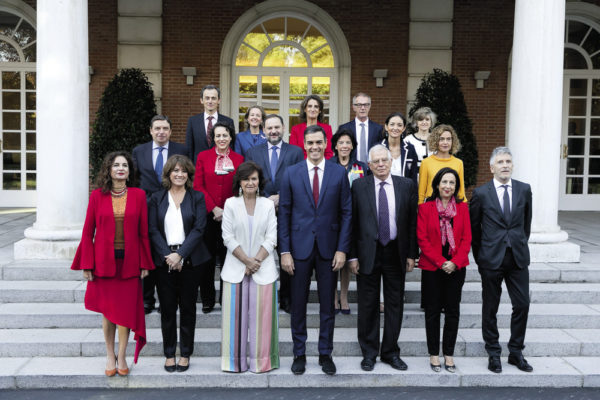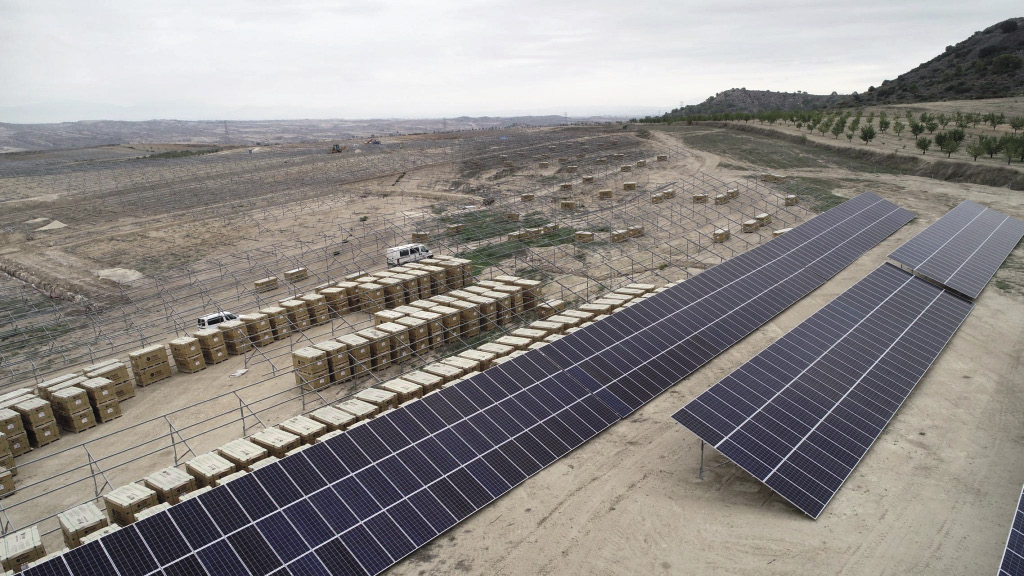From pv magazine, December edition
Spain is not only becoming the most attractive European PV market, it is also set to return to its former glory as the largest in 2019 as the result of auctions, increased activity in the PPA segment, and more distributed generation. According to forecasts given to pv magazine by the European solar association SolarPower Europe, in 2018 alone newly installed PV capacity in the country will reach around 714 MW, while in 2019 solar growth may bring numbers not seen in Europe for several years.
Great expectations
SolarPower Europe has formulated three scenarios for the growth of Spanish PV in the next year: a low scenario predicting 1,731 MW of new additions, a mid scenario providing 3,266 MW, and a high scenario with a remarkable 9,798 MW. In the V Solar Forum, “PV leading the energy transition,” held by Spanish PV association UNEF in Madrid this November 6 and 7, with absolute conviction, Raffaele Fait, representing SolarPower Europe said that “with 4, 5, or 6 GW, Spain will be the leading European market in 2019.”
That a minimum of approximately 4 GW of new PV will be grid-connected in Spain next year should be ensured by the deadline of the renewable energy auction held in July 2017, in which around 3.9 GW of PV capacity was assigned. These projects, in fact, must start delivering power to the Spanish grid by the end of 2019. And their construction has already begun across several sites, while the size of developers such as ACS Group, Forestalia, Endesa, and Naturgy, among others, leaves no doubt about the financial close for most of the projects.
Large-scale driven
What is quite clear for both 2018 and 2019 is that large-scale PV will be the market’s main driver, and not only as a result of auctions. Most of this year’s new capacity, indeed, will be represented by solar parks designed to sell power under a PPA. Since December 2017, when U.K.-based asset manager Foresight Group announced it had signed Spain’s first PPA for a large-scale PV project, a big bunch of similar announcements followed. According to UNEF, the combined capacity of all signed PPAs in Spain for big solar parks now exceeds 1.5 GW, with several projects under construction and some of them even finalized, such as the 170 MW PV facility built by Baywa r.e., the renewable energy arm of German agricultural and industrial conglomerate Baywa, in Alcalá de Guadaíra, Andalusia, southern Spain.

TBEA
Bankability of PPAs
Two factors have contributed to make PPAs a good deal in the Spanish solar energy landscape: the drop in module prices determined by recent changes in the Chinese PV policy which has led to overcapacity among manufacturers, and a considerable hike in power prices registered in the Spanish spot market over the past 12 months.
Dario Castagnoli, Corporate Director of Energy Management & Trading of Spanish gas and power provider Nexus Energia, believes that spot prices for the period 2020-2021 are forecast to range between €50/MWh and €55/MWh, which guarantees that a PPA signed today is bankable with a high degree of certainty for at least the first four or five years. “Subsequently, the evolution of the market price and the solar capture price will determine the profitability of the contract,” he tells pv magazine.
According to Castagnoli, currently PPAs with a duration between 10 and 15 years are being closed at a fixed price slightly lower than €40/MWh. For shorter PPAs, he also said, power is sold at a price of around €1-2/MWh lower than the curve, to compensate for the risk of the production volume. Overall, Nexus Energia has closed a 14 year PPA with X-Elio and is set to close another 19 year contract by the end of the year with an unnamed solar power producer, for a total expected annual production of 600 GWh.
The closing of a private PPA agreement might take as much as 12 months Castagnoli claims, further complicating business. “The solution of a variable price with a floor allows producers to benefit from a possible increase in prices, while ensuring a minimum return on investment,” he explains. “With a fixed price, all risk is assumed by the off-taker, which is rewarded by an initial contract price of around 20% cheaper than the market [price],” Castagnoli adds.
On the other hand, the option to sign a PPA transfers the risk from the buyer to the power producers, while also allowing entities outside the Spanish electricity market, such as hedge funds, to sign this type of contract directly with the producers. “Now PPAs can be stipulated at a fixed price of between €38/MWh and
€41/MWh, depending on the start date of production and the solvency of the off-taker,” he concludes.
Risk of grid congestion
Popular content
If both auctions and the PPA segment are said to be capable of delivering strong growth over the coming years, doubts are being raised as to the grid’s capacity to host all of the power coming from big solar parks, and to ensure fair competition among all interested parties.
The press office of the Spanish grid operator, Red Eléctrica de España (REE) tells pv magazine that the Spanish grid will have no problems integrating the 7 GW of combined solar and wind allocated in the two auctions held in the summer of 2017.
It also said, however, that 35 GW of wind and solar projects were granted connection permits, an amount that could be difficult to manage even the by most developed power network. “In the future, depending on the development, construction, and commissioning of the projects that have permits, there could be production limitations, in situations of primary energy competition, that would be managed by REE’s control centers,” the grid operator states.
“With current installed power generation capacity,” it also says, “there are no particular issues.” The REE also highlights that, currently, there are certain regulatory gaps that may find a solution in a new decree regulating grid connection (Real Decreto de Acceso y Conexión), which is now in its final phase of preparation and may be published by the end of the year.
This, and another decree issued in early October (Real Decreto-ley 15/2018), which also eliminated the notorious solar tax for distributed generation among other things, were conceived by the Spanish government to reduce uncertainty for the grid-connection process. October’s decree has postponed the deadline for all of the connection permits granted prior to 2013 to March 31, 2020, while also establishing that developers that do not meet the deadlines established by the entry into force of the decree may waive their permits until January 6, 2019.
These new provisions also imposed an increase of the guarantee required to initiate the procedures of access and connection to the distribution network from €10/kW to €40/kW installed, in an effort to reduce speculation in the market. According to UNEF, however, October’s decree leaves issues unresolved such as the criticized “only valid interlocutor of position” (interlocutor único de posición – IUP), which currently manages competition among developers to secure grid-connections to voltage points higher than 36 kV, and other points necessary to determine how new plants will be connected.
The upcoming provisions to be published by the end of the year are expected to reduce the time frame and requirements, while also improving the role of the IUP. “It is also important to ensure an adequate and stable planning over time of the installed power, to avoid bottlenecks during the installation of large plants,” UNEF President, José Donoso says. “Another challenge is the reduction of administrative processing times, so that there are no unnecessary delays to projects.”
According to Alejandro Diego Rosell, Managing Partner of Spanish solar constructor, Energoya, there is speculation in the market, especially in the main distribution and transport nodes of the power network in Spain’s southern and central regions. “There are companies whose exclusive business is to secure those connection points and speculate with them, as they have no interest in developing the projects, only to sell them in an inflationary market,” he tells pv magazine.
Rosell also believes, however, that the market is slated for more strong growth, and that it has the potential to deploy between 30 and 40 GW over the next 10 years. “After years of abuse by the administration, the Spanish photovoltaics sector demands clear and stable rules. We do not intend to have more aid or subsidies – just no more sticks in the wheel,” he states.
Prospects despite uncertainty
Spain’s minority government led by socialist Pedro Sánchez has committed to revive the domestic renewable energy sector, and solar in particular, and since it took office it has taken concrete steps including the above-mentioned October decree and the decisive shift to increase the 2030 EU renewable energy target to 32%.
However, the possibility that new elections may be held in the next summer means investors should proceed with caution. But regardless of politics, solar seems to have found a new path for development in Spain, which is more dependent on its own strengths and weaknesses. There is no doubt it will win this battle, although it is not clear how quickly it will be able to move forward in the short term.
This content is protected by copyright and may not be reused. If you want to cooperate with us and would like to reuse some of our content, please contact: editors@pv-magazine.com.



Many Spanish householders, including myself, are waiting for the policies announced in the Real Decreto for the distributed sector to become operational before we can join in the solar revival. The decree establishes that prosumers will be paid the wholesale rate for their exported surplus. To make this practical, it envisages a smoothing process: but this has still to be nailed down. Similar uncertainties cloud the announced simplification of the grid connection procedures used in the past as a red tape barrier to stifle unwelcome competition for incumbents. Theresa Ribera has made a very good start but she has to follow through.
The rules of the new decree are already pretty clear. Self consumption means to produce and use your electricity. You don’t need to produce a surplus and get paid for that. Self consumtion with PV means savings from traditional fuels and CO2 . Not a business. The figures are excellent in terms of investment, but as it happend 12 years ago, for some people is never enough. So, please move to othe “safer” investment markets. If you find them.